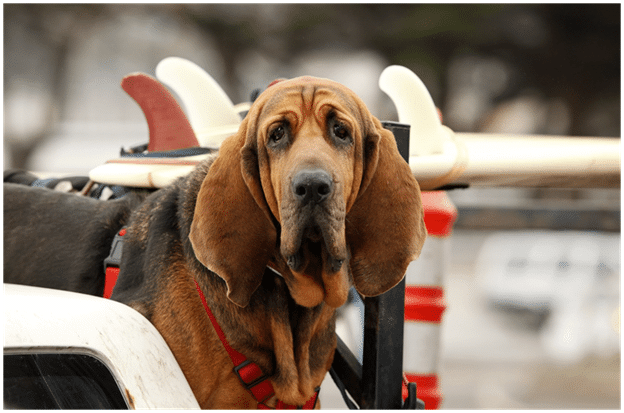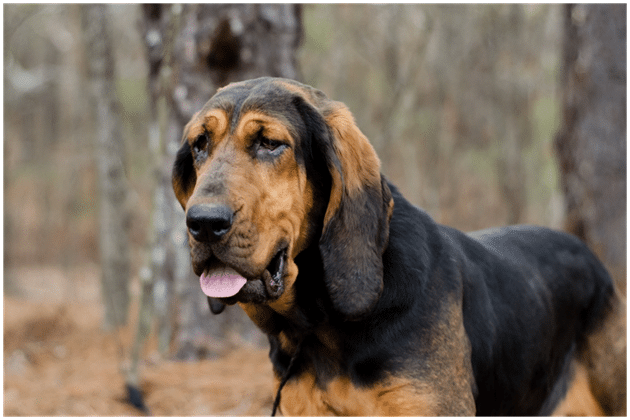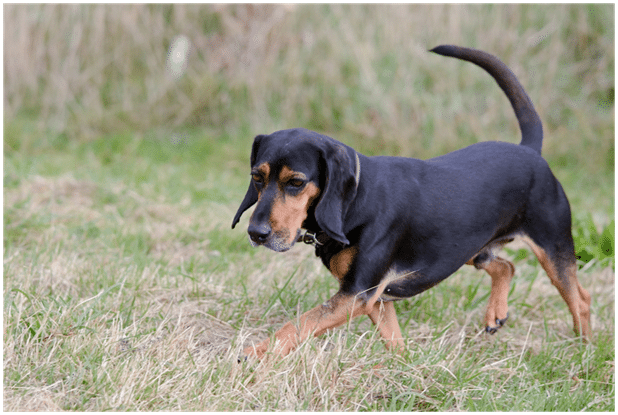Bloodhound health problems are a concern for any potential owner of this beloved breed. While these dogs are known for their exceptional tracking skills, they are also prone to certain health conditions that require close attention and care.
Bloodhounds are prone to quite a few health problems, which is why it’s critical to ensure you do your research before bringing one of these dogs into your home. The main health issues they are prone to include hip and elbow dysplasia, gastric torsion, dermatitis, and ectropion.
All of these health conditions can be quite serious and require veterinary treatment. If you’re not prepared to deal with health problems in your Bloodhound, it’s best not to adopt one of these dogs.
We explore each of these conditions below along with various treatments that are available.
Hip dysplasia
A common condition in which the hip joint doesn’t develop properly, resulting in pain and arthritis. Hip Dysplasia is one of the most common health problems with the Bloodhound and can be avoided by buying a puppy from a reputable breeder.
Also, make sure to keep your dog active and slim, as excess weight can aggravate the condition.
When a Bloodhound has hip dysplasia, they walk with a “waddling” gait and may be reluctant to go up or downstairs.
If your dog is showing these signs, it’s important to take them to the vet for an evaluation.
Pet owners should note that there is no cure for hip dysplasia, but there are treatments available that can help make your dog more comfortable.
Treatment
Treatment for hip dysplasia may include medications, surgery, or physical therapy. It’s important to work with your veterinarian to come up with a treatment plan that’s best for your dog.
“Medications include non-steroidal anti-inflammatory drugs (NSAIDs) to help reduce inflammation and pain, as well as prescription joint supplements.“
If your dog’s hip dysplasia is severe, they may need surgery. This surgery involves removing the damaged parts of the hip joint and replacing them with implants.
Some Bloodhounds also require physical therapy to help strengthen their hips and keep them mobile. Physical therapy may include exercises, massage, and hydrotherapy.
Elbow dysplasia
A condition in which the elbow joint doesn’t develop properly, resulting in pain and arthritis. Elbow Dysplasia is the most common developmental orthopedic disease in dogs. It normally occurs when the bones of the elbow joint don’t fuse together correctly.
Elbow dysplasia is more common in large and giant breeds of dogs, such as Rottweilers, Labs, and German Shepherds. However, it can occur in any breed. The condition is thought to be hereditary, but environmental factors may also play a role.
“Dogs with elbow dysplasia may walk with a limp or have difficulty rising from a lying position. They may also experience pain and inflammation in the joint, which can lead to arthritis.”
Treatment for elbow dysplasia includes medications, physical therapy, and surgery.
If you think your dog may have elbow dysplasia, have him examined by a veterinarian. Early diagnosis and treatment can help to prevent further damage to the joint and improve the dog’s quality of life.
Treatment

There is no one cure for elbow dysplasia. Treatment options include medications, physical therapy, and surgery.
Surgery is often necessary to correct the problem and may involve removing or reshaping bone fragments, repairing torn ligaments, or stabilizing the joint with screws or plates.
Physical therapy may be recommended to help the dog regain range of motion and strength. This may include exercises such as swimming and walking on a treadmill.
Medications can help to reduce inflammation and pain. NSAIDs (non-steroidal anti-inflammatory drugs) are commonly used for this purpose.
Gastric torsion
Gastric torsion: also known as bloat, is a life-threatening condition that occurs when the stomach twists, cutting off the blood supply. This can happen for a variety of reasons, such as eating too much or exercising soon after eating.
Symptoms of bloat include excessive gasping for air, restlessness, drooling, and vomiting. If you see these signs, take your dog to the vet immediately. Bloat can kill dogs in just a few hours, so it’s important to get them help as soon as possible.
There is no cure for bloat, but there are treatments that can help. Treatment may include surgery to untwist the stomach, fluids and antibiotics to treat dehydration and infection, and pain medications.
Preventing bloat is the best way to protect your Bloodhound. Some ways to help prevent bloat include avoiding large meals, feeding multiple small meals throughout the day, and not exercising your dog right after eating.
Dermatitis (or skin allergies)
Dermatitis is a term used to describe a wide variety of skin conditions, most of which are caused by allergies. Dogs can be allergic to anything, including food, pollen, grass, and dust mites.
Symptoms of dermatitis vary depending on the type of allergy. They can include itching, scratching, biting, and licking of the skin; hair loss; redness, inflammation, and swelling; and sores or lesions on the skin.
Treatment for dermatitis depends on the cause of the allergy. If the allergy is food-related, the dog may need to be put on a special diet. Environmental factors may also be the cause, such as pollen or dust mites.
The dog may need to be treated with antibiotics, anti-inflammatory drugs, or steroids.
If your Bloodhound is showing signs of dermatitis, have him examined by a veterinarian. Early diagnosis and treatment can help to control the symptoms and improve the dog’s quality of life.
Ectropion
Bloodhounds often suffer chronic eye irritation. An example of this is Ectropion. This condition is an eyelid abnormality in which the lower eyelid droops, exposing the inner surface of the eye. This can result in constant irritation and cause the dog to have a watery or irritated eye.
Ectropion can be caused by a variety of factors, such as genetics, age, and injury. It may also occur as a side effect of some medications.
There is no cure for ectropion, but it can be treated with surgery. Surgery involves tightening the eyelid muscles and/or removing excess skin.
If your Bloodhound has ectropion, have him examined by a veterinarian. Early diagnosis and treatment can help to prevent further damage to the eye and improve the dog’s quality of life.
Otitis externa (ear infection)
Oitis externa, also known as ear infection, is a common problem in dogs. It is caused by bacteria or yeast that accumulates in the ear canal, resulting in inflammation and discharge.
Symptoms of otitis externa include scratching or rubbing of the ear, head shaking, excessive wax production, and foul-smelling discharge.
Otitis externa can be treated with antibiotics or antifungal medications, depending on the cause of the infection. The dog may also need to be bathed three times a week with an ear cleaning solution to help remove the bacteria or yeast.
If your Bloodhound is showing signs of an ear infection, have him examined by a veterinarian. Early diagnosis and treatment can help to clear up the infection and prevent further damage to the ear.
Simple ways to prevent common health issues in Bloodhounds:
Monitor behavior changes

Watch out for behavioral changes, such as excessive gasping for air, restlessness, drooling, and vomiting.
Avoid large meals, feeding multiple small meals throughout the day, and not exercising your dog right after eating.
Monitor your dog for skin allergies and ectropion.
Monitor your dog for ear infections.
Groom Regularly
The following key tips will help keep on top of grooming your Bloodhound:
- Regularly brush his coat to keep it clean and free of parasites.
- Check your dog’s ears regularly for wax accumulation, redness, or inflammation.
- Clean your dog’s wrinkles daily to prevent bacterial infections.
- Take your dog to the vet for regular check-ups, including routine vaccinations and preventive care.
Manage parasites
Manage parasites by using a veterinarian-approved flea and tick control product. Keeping your home clean will also make a big difference. You want to ensure your home is free of dust mites, pollen, and other allergens.
You should also take your dog to the vet for regular check-ups, including routine vaccinations and preventive care.
Have your Bloodhound Spayed or Neutered
Prospective owners of Bloodhounds may be wondering whether spaying or neutering your dog is best for their health. Spaying or neutering your Bloodhound can help to prevent health problems such as cancer, obesity, and urinary tract infections.
It can also help to reduce the risk of behavioral problems. The suggested time frame for spaying or neutering is 6 to 9 months of age, however, for large dogs, this could be as late as eighteen to twenty-four months.
Failing to spay or neuter your dog can result in unexpected litters of puppies, many of which will end up in animal shelters. Unwanted puppies can also be costly and time-consuming to care for.
Spaying or neutering your Bloodhound is a simple way to help keep him safe while reducing the risk of health problems.
While this procedure can reduce the risk of unplanned litters and stray dogs, it’s always best to talk to your veterinarian first. They can discuss with you the best time to do this and to ensure health concerns are clearly understood beforehand.
Prevent Dehydration in your Bloodhound

Dehydration can be a serious problem with the Bloodhound, leading to health problems such as heat stroke, seizures, and even death.
Bloodhounds are prone to dehydration because they have a high ratio of skin to body weight and they pant excessively when they get hot.
To prevent dehydration in your Bloodhound, be sure to provide plenty of fresh, cool water and make sure he has access to shade or a cool area when he is outside.
If your dog begins to pant excessively or shows other signs of dehydration, call your veterinarian immediately.
Keep them Active (physically and mentally)
Bloodhounds are famous for being scent hounds and are natural explorers. They are an active breed who are always on the move. They make amazing family dogs, however, need regular exercise to stay healthy and happy.
Not only does exercise help keep dogs physically fit, it also helps keep them mentally stimulated and prevents them from becoming bored.
Ensure you provide your Bloodhound with a good mix of aerobic and strength-training exercises each week.
However, keep in mind that exercise shouldn’t be too strenuous until they reach physical maturity. The following is a good guide to work off:
- Take your Bloodhound for a long walk or jog each day.
- Include some basic obedience commands in your training routine. Consistent training sessions should take place.
- Play fetch with your dog.
- Rotate toys regularly to keep your dog entertained.
- Provide a mentally stimulating environment by hiding treats or toys around the house for him to find.
- Take your Bloodhound to the park or play in the backyard.
- Always ensure adequate amounts of water, especially when they are exercising.
By following the above tips, your Bloodhound will likely grow to become a good-tempered, healthy family companion.
Regular check-ups with the Vet
To ensure optimal health care, it’s important to take your Bloodhound to the veterinarian for regular check-ups. This includes routine vaccinations and preventive care.
Vets can provide advice on how to keep your Bloodhound healthy and may be able to detect health problems before they become serious.
Routine vaccinations can help protect your dog from diseases such as rabies, parvo, and distemper.
Preventive care can help to keep your dog healthy by detecting and treating health problems early.
Your veterinarian can also provide advice on parasite control, nutrition, and exercise for your Bloodhound.
It is best to adopt a preventative and proactive approach to managing the health of your Bloodhound. This will help to identify health issues early and optimize their quality of life for many years to come.
Final thoughts
All in all, there are a few things that you can do to minimize the risk of health problems with your Bloodhound. Make sure to provide plenty of fresh water, exercise, and regular check-ups with the veterinarian.
In addition, spaying or neutering your dog can help reduce the risk of health problems. Keep your Bloodhound active both physically and mentally to ensure he remains healthy and happy. By following these simple tips, you can help your Bloodhound live a long and healthy life.


